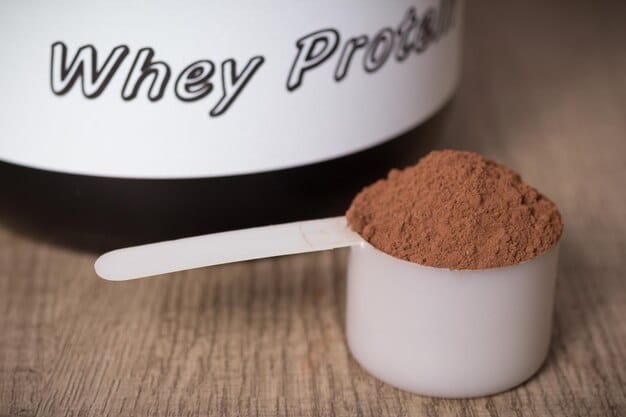The 2025 Guide to Choosing Your Ideal Protein Powder

Navigating the vast selection of protein powders in 2025 requires understanding individual dietary needs, fitness goals, and ingredient quality to make an informed choice that truly supports one’s health and performance.
In the dynamic world of health and fitness, selecting the optimal protein powder can often feel like a complex puzzle. This comprehensive The 2025 Guide to Choosing the Right Protein Powder for Your Needs aims to demystify the options, helping you navigate the latest advancements and find a supplement perfectly aligned with your unique goals and lifestyle.
Understanding the Basics of Protein Powder
Protein powder has become a staple in many nutritional strategies, offering a convenient way to increase protein intake. Yet, its true value lies in understanding what it is, how it functions in the body, and why it has earned its widespread acclaim among athletes, fitness enthusiasts, and those simply aiming to improve their general wellness.
At its core, protein powder is a concentrated source of protein derived from various sources, providing essential amino acids crucial for muscle repair, growth, enzyme production, and overall bodily function. The market offers a diverse array of options, each with unique benefits and applications, ranging from dairy-based to plant-based formulations, tailored to accommodate a spectrum of dietary preferences and health objectives.
What is Protein and Why is it Important?
Protein is a macromolecule composed of amino acids, often referred to as the “building blocks” of life. It plays an indispensable role in nearly every biological process, from cellular repair to immune system support. Optimal protein intake is paramount for:
- 💪 Muscle Synthesis: Crucial for repairing muscle tissue damaged during exercise and facilitating the growth of new muscle.
- 🦴 Bone Health: Contributes to bone density and strength, reducing the risk of osteoporosis.
- ⚖️ Satiety and Weight Management: Promotes feelings of fullness, which can aid in controlling appetite and supporting healthy weight loss or maintenance.
- 🛡️ Immune Function: Provides the necessary components for antibodies and immune cells that defend the body against illness.
Without adequate protein, the body struggles to perform these vital functions efficiently, potentially leading to muscle loss, weakened immunity, and a general decline in well-being. Protein powders serve as an accessible and efficient means to meet increased protein demands, especially for those with active lifestyles or specific dietary restrictions.
As we delve deeper into 2025, the innovations in protein powder formulations reflect a greater understanding of personalized nutrition. Manufacturers are now focusing on enhancing bioavailability, improving digestive comfort, and addressing niche dietary requirements, making the selection process more nuanced but ultimately more rewarding for the informed consumer.
This foundational understanding of protein’s role and the general concept of protein powders sets the stage for exploring the specific types available and how to align them with your individual needs, ensuring you make a choice that genuinely supports your health journey.
Key Factors to Consider Before Buying
Before committing to a protein powder, it’s essential to assess several crucial factors that will guide you toward the most suitable product. The market is saturated with options, and a discerning eye, backed by knowledge, will prevent costly mistakes and ensure optimal results.
Your fitness goals, dietary restrictions, and even the time of day you plan to consume the protein are all pivotal in making an informed decision. Ignoring these elements can lead to suboptimal performance, digestive discomfort, or simply not achieving the desired outcomes from your supplement.
Dietary Restrictions and Allergies
This is arguably the most critical consideration. Many popular protein powders are dairy-based, primarily derived from milk. If you are lactose intolerant, have a milk allergy, or follow a vegan lifestyle, these options are immediately off-limits. Fortunately, the plant-based protein market has exploded, offering excellent alternatives. Common plant-based sources include:
- 🌿 Pea Protein: Highly digestible and rich in branched-chain amino acids (BCAAs).
- 🌱 Rice Protein: Often combined with pea protein to create a complete amino acid profile.
- 🎃 Hemp Protein: Contains omega-3 and omega-6 fatty acids, plus fiber.
- 🌻 Soy Protein: A complete protein, though some individuals prefer to avoid it due to potential hormonal effects or common allergies.
Beyond dairy and soy, check for other allergens like gluten, nuts, or specific sweeteners that might trigger adverse reactions. Always scrutinize the ingredients list, particularly the “Contains” statement, to ensure it aligns with your dietary needs.

Fitness Goals and Activity Level
Your fitness objectives play a significant role in determining the ideal protein powder. Are you aiming for muscle gain, weight loss, or general health maintenance?
For muscle building and recovery, especially post-workout, a fast-absorbing protein like whey isolate is often recommended due to its high BCAA content. Casein, a slow-digesting protein, is excellent for sustained release, making it ideal before bedtime to prevent muscle breakdown during sleep.
If weight loss is your goal, look for protein powders that are low in calories, sugar, and fat, and that offer a good protein-to-calorie ratio. Protein can help boost metabolism and increase satiety, aiding in caloric control. For endurance athletes, a blend of fast and slow-digesting proteins might be beneficial to provide sustained energy and support recovery over longer periods.
Your activity level also dictates your protein needs. A highly active individual will naturally require more protein than someone with a sedentary lifestyle. Adjust your portion sizes and frequency based on your training intensity and frequency to optimize results.
Taste and Mixability
While not a health-related factor, taste and mixability significantly impact long-term adherence. Even the most scientifically superior protein powder will gather dust if you dread drinking it. Most brands offer a variety of flavors, from classic chocolate and vanilla to more exotic options. Consider purchasing single-serving packets if available to sample flavors before investing in a large tub.
Mixability refers to how easily the powder dissolves in liquid without clumping. A good protein powder should dissolve smoothly with minimal effort, whether shaken in a bottle or blended. Read reviews for feedback on mixability, as a gritty or foamy texture can be off-putting.
By carefully evaluating these factors, you can narrow down the vast selection and identify a protein powder that not only supports your health and fitness goals but also fits seamlessly into your daily routine and preferences, contributing positively to your overall well-being.
Comparing Different Types of Protein Powders
The protein powder market is rich with variety, broadly categorized by their source: animal-based or plant-based. Each type comes with its own set of advantages, ideal use cases, and considerations. Understanding these differences is paramount to making an informed choice that aligns with your specific needs and ethical preferences.
This section will explore the most popular protein powder types, highlighting their unique characteristics in terms of absorption rate, amino acid profile, and potential benefits, enabling you to select wisely in 2025.
Whey Protein (Isolate, Concentrate, Hydrolysate)
Derived from milk during the cheese-making process, whey protein is one of the most popular and extensively researched protein sources, known for its rapid digestion and rich amino acid profile, particularly BCAAs. There are three primary forms:
- 🥛 Whey Concentrate: Contains 70-80% protein, with varying amounts of lactose, fat, and carbohydrates. It’s the most common and often the most cost-effective form. Its slightly higher carbohydrate and fat content give it a creamier texture and broader flavor profile.
- ✨ Whey Isolate: Undergoes further processing to remove most of the lactose, fat, and carbohydrates, resulting in a protein content of 90% or higher. It’s an excellent choice for individuals with mild lactose intolerance or those strictly limiting calorie and carbohydrate intake. It absorbs slightly faster than concentrate.
- ⚡ Whey Hydrolysate: The most processed form, where the protein is pre-digested (hydrolyzed) into smaller peptides. This makes it the fastest absorbing and easiest to digest, ideal for post-workout recovery when quick amino acid delivery is crucial. However, it’s typically the most expensive and can have a slightly bitter taste.
Casein Protein
Also derived from milk, casein protein differs significantly from whey in its digestion and absorption rate. Casein forms a gel-like substance in the stomach, leading to a slow and sustained release of amino acids into the bloodstream over several hours. This makes it an “anti-catabolic” protein, ideal for:
- 🌙 Nighttime Use: Provides a steady supply of amino acids during sleep, preventing muscle breakdown.
- ⏳ Extended Recovery: Beneficial during long periods between meals or during fasting.
Casein is less commonly used directly post-workout due to its slow absorption but is highly valued for its sustained release properties and ability to promote satiety.
Plant-Based Proteins (Pea, Rice, Hemp, Soy, Blends)
With the rise of veganism and increased awareness of dietary sensitivities, plant-based protein powders have gained immense popularity. While individual plant proteins may have varying amino acid profiles, intelligent blending can create a comprehensive and complete protein source:
- Pea Protein: A good source of BCAAs, often compared to whey in its muscle-building capabilities.
- Brown Rice Protein: Lower in lysine than pea protein, hence often combined to create a complete profile. It’s hypoallergenic and easily digestible.
- Hemp Protein: A complete protein containing omega-3 and omega-6 fatty acids, along with fiber. It has an earthy taste and can be slightly gritty.
- Soy Protein: A complete, high-quality protein, but its popularity
is sometimes tempered by concerns over phytoestrogens or common allergies. - Plant Protein Blends: Many manufacturers combine two or more plant proteins (e.g., pea and rice) to ensure a complete amino acid profile that rivals animal-based proteins. These blends often offer superior texture and taste compared to single-source plant proteins.
When choosing a plant-based protein, consider not just the protein source but also the additional ingredients, such as digestive enzymes or added vitamins, which can enhance its nutritional value and digestibility. The innovation in plant-based formulations continues to make them increasingly competitive with their animal-derived counterparts in 2025.
Decoding Labels and Third-Party Certifications
In a market flooded with various claims and promises, being able to critically evaluate protein powder labels and understand the significance of third-party certifications is crucial. This knowledge empowers you to make genuinely informed decisions about the quality, purity, and safety of the products you consume.
A product label is more than just a list of ingredients; it’s a comprehensive nutritional profile and an indicator of the manufacturer’s transparency and commitment to quality. Learning to read beyond marketing claims and focus on the substantive details will serve you well in 2025.
Understanding the Nutrition Facts Panel
The “Nutrition Facts” panel provides a wealth of information about the macronutrient content of your protein powder. Pay close attention to:
- 📊 Serving Size: This is the basis for all other values listed. Ensure you understand what one serving entails.
- 📈 Calories: Total energy per serving. High-calorie protein powders might not be ideal for weight loss goals.
- 🥩 Total Protein: The most crucial metric. Aim for at least 20-30 grams per serving for most applications.
- 📉 Carbohydrates (Sugars, Fiber): Check for added sugars, which can negate health benefits. Fiber content can affect digestibility.
- 🧈 Fats (Saturated, Trans): Generally, you want these to be low, especially saturated and trans fats.
Beyond macronutrients, look for the amino acid profile, if provided. A complete protein will contain all nine essential amino acids. For muscle growth, pay particular attention to Leucine, Isoleucine, and Valine (BCAAs).
Ingredient List Scrutiny
The ingredient list reveals the actual components of the protein powder, listed in descending order by weight. A shorter, simpler ingredient list is often a good sign. Be wary of:
- 🍬 Artificial Sweeteners: Aspartame, sucralose, saccharin. While generally safe in moderation, some individuals prefer natural alternatives like stevia or monk fruit.
- 🎨 Artificial Flavors and Colors: These add no nutritional value and can sometimes cause sensitivities.
- fillers and gums: Dextrin, maltodextrin, xanthan gum. While typically safe, excessive amounts can dilute the protein content.
Also, check for the main protein source (e.g., “whey protein isolate” vs. “protein blend”) and any added digestive enzymes (like lactase), which can be beneficial for digestion.

The Importance of Third-Party Certifications
Unlike food products, dietary supplements are not as strictly regulated by the FDA before they hit the market. This is where third-party certifications become invaluable. These independent organizations test products for purity, potency, and absence of contaminants (including banned substances).
Key certifications to look for include:
- ✅ NSF Certified for Sport: Guarantees the product is free of banned substances, contaminants, and that what’s on the label is in the product. Highly recommended for competitive athletes.
- ✅ Informed-Sport: Similar to NSF, this certification ensures products are free of substances banned in sport.
- ✅ USP Verified: Confirms that the product contains the ingredients listed on the label in the declared potency and dosage, doesn’t contain harmful levels of contaminants, and will break down and release into the body within a specified amount of time.
- ✅ Certified Organic: Ensures ingredients are grown and processed according to organic standards if you prioritize organic foods.
Choosing a protein powder with one or more of these certifications provides an extra layer of assurance regarding product quality and safety, helping you invest confidently in your health in 2025.
When and How to Use Protein Powder Effectively
Once you’ve chosen the right protein powder, understanding when and how to incorporate it into your diet is crucial for maximizing its benefits. Protein powder isn’t a magical supplement; its effectiveness largely depends on strategic timing and proper usage aligned with your overall nutritional and fitness strategy.
The timing of protein intake, the method of consumption, and its integration into a balanced diet are all key aspects that should be considered to reap the full advantages of your chosen supplement, particularly in 2025 where personalized nutrition is gaining prominence.
Optimal Timing for Protein Intake
The concept of an “anabolic window” immediately post-workout has been widely discussed, yet research in 2025 suggests that while beneficial, acute timing might be less critical than total daily protein intake. However, strategic timing can still enhance specific outcomes:
- ⏰ Post-Workout: Consuming protein within an hour or two after resistance training is highly recommended. Fast-absorbing proteins like whey hydrolysate or isolate are ideal here to kickstart muscle repair and growth.
- 🍽️ Between Meals: A protein shake can serve as an excellent snack to curb hunger, especially if you’re aiming for satiety or increased protein intake throughout the day to support muscle maintenance or growth.
- 🌅 Morning/Breakfast: Adding protein to your breakfast (e.g., in a smoothie) can help increase satiety, stabilize blood sugar levels, and provide a good start to your daily protein intake.
- 🌙 Before Bed: Slow-digesting proteins like casein are perfect before sleep, providing a sustained release of amino acids overnight to prevent muscle breakdown and support recovery.
- ⬆️ Weight Management: Consuming protein before meals or as meal replacements (with adequate fiber and nutrients) can increase satiety and reduce overall calorie intake, supporting weight loss efforts.
Methods of Consumption
Protein powder is incredibly versatile and can be consumed in various ways beyond the typical shake, making it easy to integrate into diverse diets and routines:
- 🥤 Shakes: The most common method. Mix with water, milk (dairy or non-dairy), or juice. A blender bottle or a simple spoon can suffice for good mixability.
- Blend in Smoothies: Combine with fruits, vegetables, yogurt, or nut butter for a nutrient-dense meal replacement or snack. This can also mask the flavor of some less palatable protein powders.
- 🧑🍳 Baked Goods: Add to oatmeal, pancakes, muffins, or energy bars to boost their protein content. Be mindful that heat can sometimes denature proteins, but they still retain their amino acid value.
- 🥣 Yogurt/Oatmeal: Stir into plain yogurt or cooked oatmeal for an easy protein boost, especially at breakfast.
Experiment with different methods to find what works best for your taste preferences and daily routine. The aim is to make protein consumption an enjoyable and sustainable part of your nutritional strategy.
Integrating into a Balanced Diet
It’s crucial to remember that protein powder is a supplement, not a replacement for whole foods. It should complement, not substitute, a diet rich in whole protein sources, fruits, vegetables, healthy fats, and complex carbohydrates. Relying solely on protein powder can lead to nutrient deficiencies and miss out on the other beneficial compounds found in natural foods.
Ensure your overall daily protein intake meets your specific goals, with protein powder contributing to that total as a convenient tool. Consult with a registered dietitian or nutritionist to tailor your dietary strategy, especially if you have specific health conditions or ambitious fitness goals. By integrating protein powder intelligently into a balanced and varied diet, you can significantly enhance your body’s ability to recover, grow, and perform at its best in 2025.
Common Misconceptions and FAQs About Protein Powder
Despite its widespread use, protein powder is often surrounded by various misconceptions and questions. These can range from concerns about its impact on kidney health to its suitability for different age groups or gender, leading to unnecessary apprehension for many potential users.
Addressing these common queries with factual, evidence-based information is essential for promoting informed decision-making and ensuring users can confidently incorporate protein powder into their nutritional regimen in 2025.
Debunking Myths: Kidney Damage, Muscle Bulk, and More
Several persistent myths about protein powder can deter individuals from using it effectively:
- Myth: Protein powder damages kidneys.
Fact: For healthy individuals, consuming high protein diets (including protein powder) does not cause kidney damage. Extensive scientific research consistently supports this. However, individuals with pre-existing kidney conditions should consult a doctor or dietitian before significantly increasing protein intake.
- Myth: Protein powder is only for bodybuilders and will make you “bulky.”
Fact: Protein is essential for muscle repair and growth, but protein powder alone will not make you bulky. Muscle gain depends on many factors, including resistance training, overall caloric intake, genetics, and hormone levels. Protein simply provides the building blocks; how your body uses them depends on your overall lifestyle and training. Women, in particular, often fear becoming “too muscular,” but physiological differences make it much harder without specific, intense training regimens.
- Myth: All protein powders are the same.
Fact: As discussed, protein powders vary significantly in source (whey, casein, plant-based), processing (concentrate, isolate, hydrolysate), absorption rates, amino acid profiles, and additional ingredients. Choosing the right type for your goals and dietary needs is crucial.
- Myth: Protein powder is unnatural or harmful.
Fact: Protein powders are derived from natural food sources (milk, peas, rice, etc.) that have been processed to concentrate their protein content. When sourced from reputable manufacturers and used appropriately, they are safe and can be a beneficial part of a balanced diet.
Who Can Benefit from Protein Powder?
Protein powder is not exclusive to elite athletes or bodybuilders; a wide range of individuals can benefit from its convenient protein boost:
- 🏋️ Athletes and Active Individuals: For muscle repair, recovery, and growth, enhancing performance and minimizing downtime.
- 🌱 Vegetarians and Vegans: To ensure adequate intake of essential amino acids that might be harder to obtain from plant-based whole foods alone.
- 👵 Older Adults: To combat sarcopenia (age-related muscle loss) and maintain muscle mass, crucial for mobility and quality of life.
- ⚖️ Individuals on Weight Management Plans: Protein promotes satiety, helping to control appetite and preserve muscle mass during calorie restriction.
- 🍽️ Busy Professionals: As a quick, convenient meal or snack option when whole food protein sources are unavailable.
- convalescing individuals: To support tissue repair and recovery after illness or injury.
Essentially, anyone struggling to meet their daily protein requirements through whole foods alone, or those with specific goals that demand higher protein intake, can find protein powder to be a valuable dietary addition in 2025.
However, it is always recommended to consult with a healthcare professional, registered dietitian, or sports nutritionist before making significant dietary changes, especially for individuals with underlying health conditions or those who are pregnant or breastfeeding.
Future Trends in Protein Powder for 2025 and Beyond
The protein powder market is dynamic, constantly evolving with new scientific discoveries, consumer demands, and technological advancements. As we look into 2025 and beyond, several exciting trends are shaping the future of protein supplementation, moving towards more personalized, sustainable, and functional products.
These emerging trends reflect a growing consumer awareness of overall health, environmental impact, and the desire for supplements that offer more than just muscle support. Staying abreast of these developments can help you anticipate future innovations and refine your choices.
Personalized Nutrition and AI Integration
One of the most significant trends is the shift towards highly personalized nutrition. Expect to see protein powders tailored not just to general goals (e.g., muscle building) but to individual genetic profiles, microbiome data, and specific metabolic needs. AI-driven platforms may analyze consumer data to recommend precise protein types, dosages, and even custom blends, optimizing outcomes like never before.
This could involve subscription services delivering bespoke protein formulations based on real-time activity levels, dietary changes, or even biometric feedback from wearable devices. The future promises a protein powder that is truly “yours,” unique to your body’s demands in 2025.
Sustainable Sourcing and Eco-Conscious Packaging
As environmental concerns grow, consumers are increasingly prioritizing sustainability. The protein industry is responding by exploring more eco-friendly protein sources and packaging solutions:
- Insect Proteins: While niche, cricket and mealworm proteins are highly sustainable, requiring significantly less land, water, and feed than traditional livestock. Research into palatability and widespread acceptance is ongoing.
- Algae-Based Proteins: Algae offers a high-protein, nutrient-rich source that can be cultivated with minimal environmental impact. Expect to see more products incorporating spirulina, chlorella, and other algal proteins.
- Upcycled By-products: Innovations in upcycling food waste, such as protein extracted from spent grains from breweries or potato processing, are gaining traction, promoting circular economy principles.
In terms of packaging, biodegradable pouches, reusable containers, and even dissolvable sachets are likely to become more commonplace, reducing the industry’s plastic footprint and appealing to environmentally conscious consumers.
Enhanced Functionality and Nootropic Integration
Protein powders are moving beyond simple muscle building to offer broader health benefits. We will see more “functional” protein blends that incorporate ingredients targeting specific needs:
- 🧠 Nootropics and adaptogens: Protein powders might include ingredients like lion’s mane mushroom, ashwagandha, or L-theanine to support cognitive function, stress reduction, and overall mental well-being alongside physical recovery.
- 🦠 Gut Health Support: Increased inclusion of probiotics, prebiotics, and specific digestive enzymes to improve gut microbiome health, which in turn enhances nutrient absorption and overall wellness.
- 😴 Sleep and Recovery Blends: Protein powders designed for nighttime use may be fortified with ingredients like magnesium, tart cherry, or tryptophan to optimize sleep quality and accelerate recovery.
These advancements signify a shift towards holistic health, where protein powder is viewed as a versatile tool for comprehensive well-being rather than just a fitness supplement. The protein landscape in 2025 is poised to be more innovative, responsible, and tailored than ever before, reflecting a deeper understanding of human health and environmental stewardship.
| Key Point | Brief Description |
|---|---|
| 🎯 Goal Alignment | Match powder type to your fitness goals (muscle gain, weight loss). |
| 🥛 Source & Diet | Choose between dairy (whey, casein) or plant-based options based on dietary needs. |
| 🏷️ Label Check | Scrutinize nutrition facts, ingredients, and third-party certifications for quality. |
| ⏰ Timing & Usage | Consider when to take protein (post-workout, before bed) and how to consume it effectively. |
Frequently Asked Questions About Protein Powder
Yes, protein powder can be safely consumed daily as part of a balanced diet, provided it fits your overall caloric and macronutrient needs. For healthy individuals, it acts as a convenient and efficient way to meet daily protein requirements, especially for those with active lifestyles or specific dietary restrictions like vegetarianism or veganism. Always ensure you’re hydrating well and getting other nutrients from whole foods.
Protein powder can indeed aid in weight loss due to its ability to promote satiety and preserve muscle mass during caloric restriction. Protein is more satiating than carbohydrates or fats, helping to reduce overall calorie intake. It also supports metabolism. However, it should be part of a calorie-controlled diet and combined with regular physical activity for effective and sustainable results.
Whey concentrate contains 70-80% protein, along with varying amounts of fat, carbohydrates, and lactose. Whey isolate undergoes further processing to remove most of these non-protein components, resulting in a product that’s 90% or more protein. Isolate is faster absorbing and often better for those with lactose sensitivity, while concentrate is typically creamier and more cost-effective.
Modern plant-based protein blends (e.g., pea and rice protein) can be just as effective as whey in supporting muscle growth and recovery. While individual plant proteins may lack one or more essential amino acids, combining different sources creates a complete amino acid profile, comparable to animal-based proteins. Their effectiveness largely depends on the specific blend and the overall dietary context.
While protein powder is generally safe for most healthy individuals, it’s advisable to consult with a healthcare professional or registered dietitian, especially if you have pre-existing health conditions (like kidney disease), are pregnant or breastfeeding, or are taking medications. They can provide personalized advice based on your individual health status and nutritional needs, ensuring safe and effective use.
Final Considerations for Your Protein Powder Journey
Choosing the right protein powder in 2025 is less about following a trend and more about making an informed decision that aligns with your personal health objectives, dietary restrictions, and lifestyle. This guide has aimed to equip you with the knowledge needed to confidently navigate the diverse market, from understanding basic protein functions to decoding complex labels and anticipating future innovations. Remember, protein powder is a powerful dietary tool when used correctly, complementing a balanced diet and a consistent fitness routine. By prioritizing quality, understanding your specific needs, and staying updated on evolving trends, you can truly harness the benefits of protein supplementation to achieve your wellness and performance goals.





